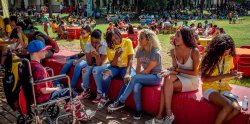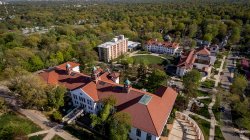Montclair State University will sustain an inclusive environment where all students and employees have the opportunity to thrive and which embraces and realizes the opportunities inherent in the rich diversity of the University community.
Objective 2.1
Capitalize on the historic strength of diversity in the institution and continue to grow that strength as the State expands its diversity.
Strategies
a) Revitalize and re-charge the President’s Commission on Affirmative Action given our successes (e.g., HSI, LBGTQ status, etc.) to further champion diversity and inclusiveness
b) Continue to refine the University’s student recruitment practices to attract and recruit applicants that are fully reflective of the diversity of New Jersey, including under-served socio-economic students, all racial and ethnic groups, and national and international students for whom Montclair State can be a welcoming community
c) Develop, administer, and analyze a regularly deployed climate survey instrument to guide enhancements of the campus environment and culture
d) Continue to implement and improve hiring and retention practices for executive, faculty, and staff from a full range of diverse populations
e) Improve the usefulness of annual performance reviews for all employees, and offer mentorship and organizational development training and support for employees and groups
Success Measures
2.1.1. Achieve racial and ethnic diversity levels (number and percent) among students that match the diversity among 18- to 24-year-olds in the State
2.1.2. Achieve racial and ethnic diversity levels (number and percent) among non-faculty employees that match the diversity of employed New Jersey residents
2.1.3. Achieve racial and ethnic diversity levels (number and percent) among faculty that match the diversity of Ph.D. recipients in their respective disciplines
2.1.4. Reduce variation among admission rates across racial and ethnic groups so that none of the differences show statistical or practical significance
2.1.5. Reduce variation among retention and graduation rates across racial and ethnic groups so that none of the differences show statistical or practical significance
2.1.6. Continue to enhance student and employee opinions regarding the campus climate for diversity in both absolute and relative terms

Objective 2.2
Reaffirm and maintain the University’s long-standing commitment to affordability.
Strategies
a) Maintain a business model in which tuition and fees will allow maximum student access to quality education
b) Employ strategic and cost efficient use of resources to assure sustainable delivery of the highest quality instruction at the lowest possible cost to students and their families
c) Develop and deliver training in general financial literacy and financial aid processes for all students
d) Continue to advocate at the State level for more equitable TAG allocations for the University’s students
e) Continue to advocate at the State level for more equitable operating support for the University
f) Increase external gifts and grants that support student scholarships
g) Increase efforts to reduce costs of attendance unrelated to tuition and fees
Success Measures
2.2.1. Maintain tuition and required fees at a level that is below the median for senior, public institutions in New Jersey
2.2.2. Reduce the number of students with unmet need, and the average amount of that unmet need
2.2.3. Reduce the average undergraduate student debt at graduation to a level that is the lowest among senior public institutions in New Jersey
2.2.4. Achieve increased TAG allocations
2.2.5. Achieve increased State appropriation for operations
2.2.6. Achieve increased external gifts and grants to support scholarships

Objective 2.3
Ensure that the university provides full access, for students, alumni, faculty and staff, to all activities that make the university an engaging community.
Strategies
a) Continue to expand accessibility to the University’s digital tools, information resources, and course materials
b) Address accessibility throughout the institution’s facilities and public spaces to achieve ADA compliance in all physical facilities and digital services
c) Communicate and encourage the effective use of innovative methods to support the diverse learning needs of disabled students, faculty, and staff
Success Measures
2.3.1. All digital resources (e.g., course materials, website information, library materials, and data bases) are accessible to the entire University community
2.3.2. All University physical facilities are accessible to the entire community

Objective 2.4
Assure that the University’s diversity, inclusiveness and provision of affordable access to excellence are conveyed clearly and consistently to the public.
Strategies
a) Publish information about diversity, inclusion and affordability in the University’s digital and printed materials
b) Portray the University’s inclusiveness by publishing images and stories about a broadly diverse array of students, faculty, staff and alumni
Success Measures
2.4.1. Improvements in awareness of the University’s diversity, inclusion and affordability by key audiences, as measured by survey research
